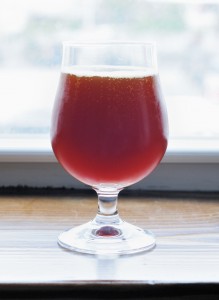Krampus, AKA Miss Figgy, is a beer of strength and contemplation that begs to be sipped. Inspired by traditional English Barley Wines and complemented by flavors of fresh fig and dark rum, this beers packs a punch at over 10% alcohol. Traditional English malts and a long boil are used to give the beer a rich malt profile of unmistakable depth. Subtle spicing is present but fleeting on the palate leaving you questioning whether you’re tasting intentional spicing or simply the play of fruit, malt, and yeast. A light touch of oak becomes apparent on the finish bringing structure to the rich malt profile.
This beer was re-brewed on a commercial scale at Big Time Brewery in Seattle, WA as part of the 2012 GABF Pro-Am Competition. It will be poured during the Friday night session of the 2012 Great American Beer Festival at the Pro-Am Competition Booth. Below I’ve outlined the beer’s recipe as well as tasting notes from a sample of the homebrewed version.
The Recipe
Size: 5.25 gal
Efficiency: 74.0%
Attenuation: 73.0%
Original Gravity: 1.106
Terminal Gravity: 1.029
Color: 20.93 SRM
Alcohol: 10.32% ABV
Bitterness: 49.4 IBU
Mash Temp: 155° F
Fermentables:
13.5 lb Crisp Maris Otter (65.1%)
3.75 lb Weyermann Munich TYPE II (18.1%)
1 lb Crisp Crystal 77 (4.8%)
8 oz Belgian Special B (2.4%)
2 lb Star Thistle Honey (9.6%)
Hops:
28 g Magnum (12.5%) – added during boil, boiled 60 m
Spice:
1 tsp Cinnamon (ground) – added during mash
.25 ea Star Anise – added during boil, boiled 5 m
Other:
1 ea Whirlfloc Tablets (Irish moss) – added during boil, boiled 15 m
.5 tsp Wyeast Nutrient – added during boil, boiled 10 m
Yeast:
1 ea WYeast 1728 Scottish Ale™
Fruit:
4 lb Figs – added dry to secondary fermenter
.5 lb Dark Raisins Soaked in Aged Dark Rum – added dry to secondary fermenter
.5 lb Golden Raisins Soaked in Aged Dark Rum – added dry to secondary fermenter
Oak:
1 oz Oak Cube Blend Soaked in Aged Dark Rum – added dry to secondary fermenter
Notes:
– Build 2800ml 1.040 starter on plate.
– Ferment primary 2 weeks. Start at 58*F and hold 60-62*F. Let ramp up to 72*F at end.
Secondary 1 (Rack to Purged Carboy) (Age 1 month):
4 lbs of figs
1/2 lb of dark raisins
1/2 lb of golden raisins
Secondary 2 (Age 2 Months):
1oz oak cubes
Tasting Notes:
Brewed: 12/4/11
Sampled: 10/7/12
Alcohol: 10.3% ABV
Aroma: This beer presents a great layered bouquet of fruit, malt, and various sugars. Initially apparent is a blend of tart cherries and prunes. As it warms, an earthy fig aroma becomes much more apparent and is reminiscent of biting into the skin of a fresh fig. Flavors of turbinado sugar and molasses sit in the background. There is a light touch of oak which is very vanilla-like. Ethanol is apparent, but not hot or distracting. The aroma is very complex and continually evolves as the beer is consumed. It seems like every sniff presents an opportunity to detect additional aromas. 12 / 12
Appearance: Deep brown with garnet-like highlights. Beer is fairly hazy. Head retention is poor, likely a consequence of the high alcohol levels. 1 / 3
Flavor: First up are flavors of heavily caramelized Belgian candi sugar that have characteristics of dark dried fruit. There is a solid amount of toasty melanoiden-rich malts (like Munich). The sugar flavors leave an impression of sweetness that is balanced with some tart-cherry like flavors. Ripe fig skin blends with some of the vanilla and oak flavors creating an interesting flavor combination. Very smooth balancing bitterness. Alcohol is barely perceptible. 19 / 20
Mouth Feel: Medium body and bitterness with soft carbonation. This beer feels like it could benefit from a heavier mouthfeel to increase its richness. 2 / 5
Overall Impression: This beer is quite nice. There are many layers of flavor which make it an enjoyable sipper that evolves in the glass. When fresh, this beer had a huge earthy fresh fig character that seems to have stepped into the background and become more integrated as the beer has aged. It is amazingly drinkable for the ABV. Really enjoyable beer. 9 / 10
Score: 43 / 50 (Outstanding)
Note: Evaluation done according to BJCP Scoring System. This beer was reviewed as a Category 20 Fruit Beer – English Barley Wine Base.

